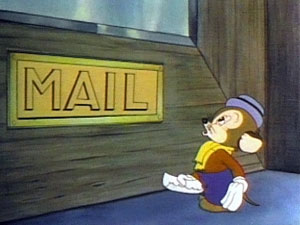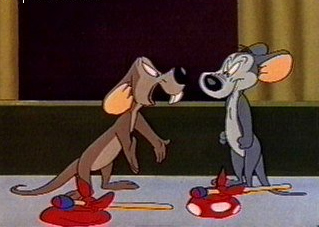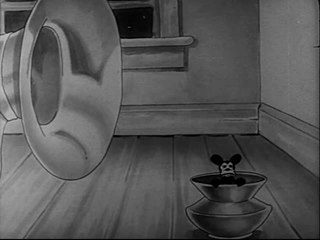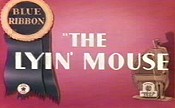Related Research Articles

Hippety Hopper is a young kangaroo character in the Warner Bros. Looney Tunes series of cartoons. Robert McKimson introduced Hippety Hopper in Hop, Look and Listen (1948), which established the pattern for future Hippety Hopper cartoons. The character appeared in 14 theatrical cartoons between 1948 and 1964.

Sniffles is an animated cartoon and comic-book mouse character in the Warner Bros. Merrie Melodies and Looney Tunes series of cartoons and comics.

José "Slowpoke" Rodríguez is a fictional animated cartoon mouse, part of the Looney Tunes' cast.

Hubie and Bertie are animated cartoon rodent characters in the Warner Bros. Looney Tunes and Merrie Melodies series of cartoons. Hubie and Bertie represent some of animator Chuck Jones' earliest work that was intended to be funny rather than cute. Seven Hubie and Bertie cartoons were produced between 1943 and 1952.

A Tale of Two Kitties is a 1942 Warner Bros. Merrie Melodies cartoon directed by Bob Clampett, written by Warren Foster, and features music by Carl W. Stalling. The short was released on November 21, 1942, and features the debut of Tweety, originally named Orson until his second cartoon, who delivers the line that would become his catchphrase: "I tawt I taw a puddy tat!"
Edward Stacey "Tedd" Pierce III was an American screenwriter and voice actor of animated cartoons, principally from the mid-1930s to the late 1950s.

Babbit and Catstello are fictional characters, based on the comedic duo Abbott and Costello, that appeared in Warner Bros. animated cartoons. The characters appeared in four cartoons between 1942 and 1946: once as cats, once as dogs, and twice as mice.

Tale of Two Mice is a 1945 Warner Bros. cartoon in the Looney Tunes series, directed by a uncredited Frank Tashlin. It is a sequel to 1942's A Tale of Two Kitties, with the Abbott and Costello characterizations now cast as mice. They are voiced by Tedd Pierce and Mel Blanc respectively.

Cheese Chasers is a 1951 Warner Bros. Cartoons Merrie Melodies cartoon directed by Chuck Jones and written by Michael Maltese. The cartoon was released on August 25, 1951 and stars Hubie and Bertie, with Claude Cat.
This is a listing of all the animated shorts released by Warner Bros. under the Looney Tunes and Merrie Melodies banners between 1960 and 1969. A total of 147 shorts were released during the 1960s.

The Mouse That Jack Built is a 1959 Warner Bros. Merrie Melodie cartoon short starring Jack Benny and the regular cast of The Jack Benny Program as mice. The short, released on April 4, 1959, was written by Tedd Pierce and directed by Robert McKimson.

It's Got Me Again! is a 1932 Warner Bros. Merrie Melodies animated short film directed by Rudolf Ising. The short was released on May 14, 1932.
The Cat Came Back is a 1936 Warner Bros. Merrie Melodies cartoon directed by Friz Freleng. The short was released on February 8, 1936.

The Fifth-Column Mouse is a 1943 Warner Bros. Merrie Melodies animated cartoon directed by Friz Freleng. The short was released on March 6, 1943.
Trap Happy Porky is a 1945 Warner Bros. Looney Tunes short directed by Chuck Jones and written by Tedd Pierce. The short was released on February 24, 1945, and features Porky Pig, along with Hubie and Bertie, an early version of Claude Cat and a prototype of Hector the Bulldog.
Cats and Bruises is a 1965 Warner Bros. Merrie Melodies cartoon directed by Friz Freleng and Hawley Pratt. The short was released on January 30, 1965, and stars Speedy Gonzales and Sylvester.
The Pied Piper of Guadalupe is a 1961 Warner Bros. Looney Tunes cartoon directed by Friz Freleng. The short was released on August 19, 1961, and stars Speedy Gonzales and Sylvester.

The Lyin' Mouse is a 1937 Warner Bros. Merrie Melodies cartoon directed by Friz Freleng. The short was released on October 16, 1937.

Hollywood Canine Canteen is a 1946 Warner Bros. Merrie Melodies cartoon directed by Robert McKimson. The short was released on April 20, 1946.
References
- ↑ Beck, Jerry; Friedwald, Will (1989). Looney Tunes and Merrie Melodies: A Complete Illustrated Guide to the Warner Bros. Cartoons. Henry Holt and Co. p. 172. ISBN 0-8050-0894-2.
- ↑ Lenburg, Jeff (1999). The Encyclopedia of Animated Cartoons. Checkmark Books. p. 52. ISBN 0-8160-3831-7 . Retrieved 6 June 2020.